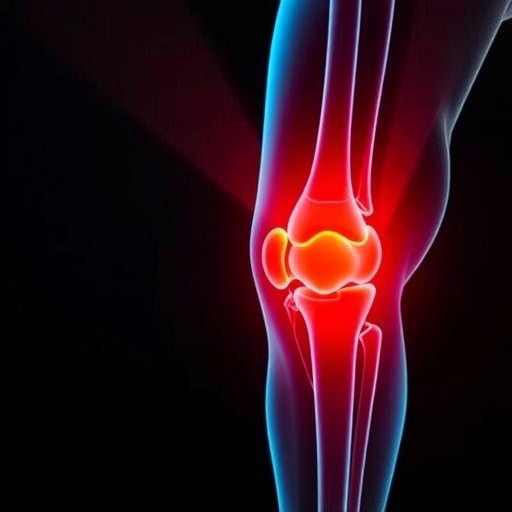A groundbreaking economic analysis spearheaded by researchers at Mass General Brigham has brought new clarity to the debate surrounding novel weight loss therapies for patients grappling with knee osteoarthritis (OA) and obesity. With the rising prevalence of obesity intensifying the burden of OA worldwide, the medical community has been increasingly focused on identifying interventions that not only alleviate symptoms but are also economically viable. This comprehensive study assesses the comparative cost-effectiveness of two cutting-edge GLP-1 receptor agonists, semaglutide and tirzepatide, alongside traditional weight loss interventions such as bariatric surgery and lifestyle modification.
Knee osteoarthritis represents a major cause of chronic pain and disability, while obesity serves as both a risk factor and a complicating element that exacerbates disease progression and diminishes quality of life. Weight reduction is known to significantly reduce joint loading and inflammation, resulting in pain relief and functional improvement. However, the introduction of pharmacologic agents like semaglutide and tirzepatide—originally developed for diabetes but now repurposed for weight management—poses questions not just about clinical efficacy but also about their economic footprint in long-term health care.
The researchers utilized OApol, a rigorously validated, state-of-the-art computer simulation model designed to project long-term outcomes in patients with knee OA. This simulation incorporated multifaceted data streams to estimate cost-effectiveness by balancing clinical benefits such as pain reduction and quality-adjusted life years (QALYs) gained against the high cost of medications. Importantly, the analysis accounted for real-world obstacles including limited insurance coverage and patient adherence challenges.
Among the novel agents evaluated, tirzepatide emerged as a frontrunner, demonstrating superior value by delivering greater health benefits at a lower overall cost compared to semaglutide. Tirzepatide’s dual agonism on GIP and GLP-1 receptors appears to enhance weight loss efficacy with potentially more favorable dosing regimens and tolerability profiles. These pharmacodynamic advantages translated into improved patient outcomes in terms of pain control and mobility, which in turn reduce the economic burden associated with advanced OA and disability.
Despite the promising profile of pharmaceutical interventions, the study emphasizes that for patients who are medically eligible and amenable to surgery, bariatric surgery remains the most cost-effective approach. Surgical weight loss offers sustained improvements in body mass indices and metabolic health, thereby providing long-term mitigation of OA symptoms and risks. The upfront costs and perioperative risks are offset by durable health gains and reduced requirements for ongoing medical therapies. Thus, from both a clinical and economic perspective, bariatric surgery may represent the optimal intervention for a select subset of obese OA patients.
Lifestyle modifications, encompassing dietary adjustments and physical activity enhancements, were also reviewed in this context. While less expensive and devoid of surgical or pharmaceutical risks, lifestyle interventions alone demonstrated limited potency and sustainability in achieving weight reduction and symptom relief compared to pharmacologic or surgical options. The study’s findings underscore the necessity of a multifaceted, tailored treatment framework that integrates patient preferences, clinical indications, and economic considerations.
A critical barrier noted in the deployment of these novel GLP-1 agents is their prohibitive cost combined with insufficient insurance coverage. This lack of financial accessibility restricts patient utilization despite the clear clinical benefits observed. Researchers advocate that robust health economic data, such as provided by this study, are instrumental in informing insurance providers and policymakers, potentially catalyzing expanded drug coverage and enhanced patient access.
Several limitations inherent to the study warrant cautious interpretation of the results. The simulation relied on aggregated data from multiple disparate sources, which may introduce variability or bias. Additionally, assumptions about the duration of patient adherence to GLP-1 therapy introduce uncertainty; real-world discontinuation rates could impact long-term cost-effectiveness. Future longitudinal studies and real-world evidence are essential to validate these model projections.
The study highlights the profound impact of knee OA and obesity on life quality and expectancy. By strategically implementing weight loss interventions, clinicians can significantly attenuate pain and disability burden, simultaneously enhancing survival rates. These findings advocate for a paradigm shift towards integrating cost-effective weight management strategies as a core element of OA care protocols.
This economic evaluation represents a crucial step forward in the evolving landscape of OA treatment, marrying clinical innovation with health system sustainability. It not only elucidates which therapies offer the greatest value but also provides actionable insights for healthcare stakeholders striving to optimize resource allocation. Such analyses are imperative in an era marked by escalating healthcare costs and an urgent need for equitable treatment access.
Beyond the immediate clinical implications, these findings may stimulate further pharmacological research aimed at refining GLP-1 receptor agonists for enhanced efficacy, affordability, and patient tolerability. The synergy between medical science, health economics, and policy has the potential to transform care paradigms for multifactorial chronic diseases such as osteoarthritis complicated by obesity.
In conclusion, the Mass General Brigham-led study decisively positions tirzepatide as a preferred pharmacologic weight loss agent over semaglutide in knee OA patients with obesity, while reaffirming bariatric surgery’s preeminent role in eligible candidates. This nuanced understanding paves the way for personalized and cost-conscious therapeutic approaches, ultimately improving patient outcomes and healthcare value.
Subject of Research: People
Article Title: The Cost-Effectiveness of Semaglutide and Tirzepatide for Patients With Knee Osteoarthritis and Obesity
News Publication Date: 15-Sep-2025
Web References:
https://www.acpjournals.org/doi/10.7326/ANNALS-24-03609
http://dx.doi.org/10.7326/ANNALS-24-03609
References:
Betensky, D. et al. “The Cost-Effectiveness of Semaglutide and Tirzepatide for Patients With Knee Osteoarthritis and Obesity” Annals of Internal Medicine DOI: 10.7326/ANNALS-24-03609
Keywords:
Arthritis, Obesity, Osteoarthritis, Weight Loss, GLP-1 Receptor Agonists, Semaglutide, Tirzepatide, Bariatric Surgery, Cost-Effectiveness, Osteoarthritis Therapy, Health Economics, Pain Management




